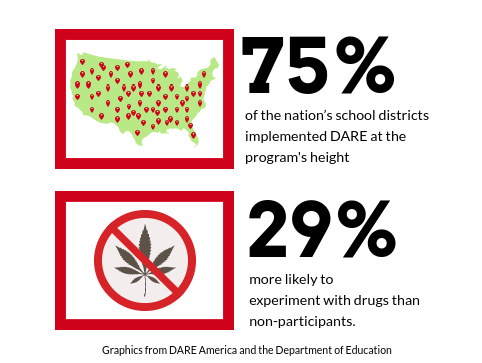“Just Say No:” Discontinue DARE in Maryland

Graphic by Charlotte Alden.
April 28, 2018
In 1983, the Los Angeles Police Department and Los Angeles Public Schools partnered to found the Drug Abuse Resistance Education program as part of the War on Drugs. The idea was simple: police officers would go into elementary and middle school classrooms and warn students about the dangerous consequences of drug use, often introducing students to drugs they didn’t even know existed.
Seventy-five percent of the nation’s school districts, including Maryland’s beginning in 1986, have implemented DARE, but numerous studies deemed its methods ineffective. In 1994, a meta-analysis funded by the Justice Department concluded DARE had little to no impact on rates of teen drug use. Some studies reported that DARE even increased drug use among participants.
Now, over 30 years after its founding, DARE continues to operate in Anne Arundel and Charles County, where classroom teachers encourage students to resist opioids as part of DARE’s updated curriculum, Keepin’ it REAL. DARE is an ineffective and insufficient program; to save lives, Maryland should discontinue the DARE program in these counties and replace it with local Narcotics Overdose Prevention & Education chapters across all Maryland school districts. NOPE is a far more effective program because it emphasizes age-appropriate education over scare tactics.
In response to numerous criticisms, national officials replaced DARE’s original curriculum with Keepin’ it REAL in 2001, which attempts to address some of the original program’s pitfalls, like its lack of interactive activities. But a 2015 study in the journal Drugs: Education, Prevention, and Policy found that due to its lack of evidence-based lessons, KiR isn’t suitable for nationwide implementation. The severity and urgency of the opioid crisis necessitates only the most effective and proven programs; we shouldn’t compromise more young lives by attempting to revive an outdated and untested program.
Now, it’s time officials replace the DARE program in Maryland counties with NOPE, an organization that emphasizes fact-based anti-drug presentations over fear-driven strategies like DARE’s use of uniformed police officers, according to a 2014 Scientific American article. Unlike DARE, NOPE only targets teenagers, ensuring that students aren’t prematurely introduced to drugs. And rather than encourage participants to “Just Say No,” local NOPE chapters use personal stories and facts to discourage teenagers from opioid use.
Long-term studies by the National Institute of Drug Abuse found effective anti-drug programs involve tailoring the programs to local situations and employing techniques that include interactivity, two core elements of NOPE that DARE and KiR fail to address. Eleven NOPE chapters already exist in the Florida and Pennsylvania areas. Creating chapters in all Maryland school districts may help to alleviate the state’s opioid crisis.
The number of teen drug overdose deaths has nearly doubled since 1999—and opioids are largely to blame, according to the Centers for Disease Control and Prevention. Many politicians recognize DARE’s failure, and some are beginning to acknowledge that KiR lacks the tried lessons to adequately address the opioid crisis. It’s time we protect the lives of Maryland teens by discontinuing and replacing DARE.









